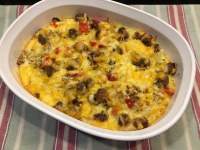Prairie Fare: Does Freezing Weather Increase the Calories We Burn?
(Click an image below to view a high-resolution image that can be downloaded)
By Julie Garden-Robinson, Food and Nutrition Specialist
NDSU Extension
When I arrived at work, the temperature was 57 F.
At this temperature, the students on campus have packed away their winter coats, scarves, hats, mittens and boots. They are wearing shorts and flip-flops.
Unfortunately, 57 degrees was the temperature in my office.
The outdoor temperature was at least 60 degrees colder, so my office was balmy, compared with sitting outside on a snowbank.
After a call to maintenance, I sat down to begin my work. I tried not to focus on being cold as I sat and shivered.
I had an old lab coat in my office, so I put that on. The thin cotton lab coat didn’t help, so I put on my “Level 3 North Dakota winter coat.”
My brown, calf-length, plush-fur-lined coat has a big hood. I probably looked like a mother grizzly bear sitting at a personal computer.
Unfortunately, my fingers were not functioning well with typing that morning. The outer office was warmer and the temperature rose to about 65 by the end of the day, as long as I kept my office door open.
I felt unusually hungry by the time my workday ended. In fact, during this long, cold winter, I have heard many people talk about wanting to eat everything in sight.
Are we really burning more calories due to the outdoor cold? That depends.
According to research conducted in the Netherlands by Wouter van Marken Lichtenbelt and colleagues, our environmental conditions can affect our metabolism. His group identified “brown fat” that is activated by exposure to cold.
Who likes to shiver? People complain when the indoor temperature is too cold.
Brown fat (or brown adipose tissue) generates heat in response to low environmental temperatures, according to rat and human studies. Even mild cold (64 F) exposure caused people to burn more calories, according to their research.
In other words, I might have been sitting at my desk losing weight. Unfortunately, I think I ate enough to compensate for the difference.
However, even nonshivering levels of cold can increase our metabolic rate to 30 percent higher than our basal metabolic rate. Our basal metabolic rate is the amount of energy we expend at rest.
Of course, to burn more calories, we also can be more physically active.
If you are standing in your window looking out at the snowbanks in a 70-degree home, you are not burning extra calories.
Let’s consider the amount of calories burned by an average 155-pound person, according to information provided by Harvard University. If you weigh more than 155 pounds, you burn more calories doing the same activity. If you weigh less than that, you would burn fewer calories.
Let’s say our example 155-pound person straps on some snowshoes and tromps through the snow for 30 minutes. That person will burn, on average, about 300 calories in a half-hour. Cross-country skiing will burn a similar number of calories per half-hour.
You could lose weight or maintain your weight with these outdoor endeavors. Burning an extra 3,500 calories through time can add up to a 1-pound weight loss, at least in theory. However, if you compensate for the activity with extra calories from food or beverages, you will be fortunate to maintain your weight.
Perhaps your outdoor activities are more utilitarian than recreational. With our snowfall, many people have spent a lot of time doing snow removal. Shoveling snow for 30 minutes will burn 223 calories.
Using a snow blower for about 30 minutes will burn about 110 calories for a 155-pound person. I don’t think many people will set aside their snow blowers and pick up a shovel to burn more calories, though.
Sitting in my chair at a computer burns about 65 calories per half-hour. Watching TV burns 28 calories per half-hour, which is only slightly more than the 23 calories per 30 minutes burned while sleeping.
As we wind down the winter months and enter March, which is National Nutrition Month, brighten your plate with colorful fruits and vegetables as we wait for the outdoors to become green again. Try to get some exercise, and stay hydrated with plenty of water.
Here’s comfort food at its finest. You may want to put on your pajamas, robe and bunny slippers when you eat this. We enjoyed it as an evening meal with cinnamon toast and orange slices. I knew it was a hit when my husband and kids went back for seconds.
Sausage, Potatoes and Cheese Breakfast Bake
16 ounces hash browns, fresh or frozen (defrosted)
Salt (optional)
12 ounces breakfast sausage links, cut into chunks (or chopped ham)
1/2 c. onion, chopped
1/2 c. red bell pepper, chopped
2 c. colby-jack or cheddar cheese (low-fat or fat-free), shredded
6 eggs
1/2 cup milk, fat-free or low-fat
1/2 tsp. black pepper
Preheat oven to 350 F. Thaw hash browns in a microwave oven if needed. Cut links into small pieces, then brown sausage in a frying pan. Add onion and pepper to the pan and saute until softened. Set aside. Spray a 9- by 9-inch casserole dish. Spread half of the hash browns in the pan. If desired, sprinkle potatoes lightly with salt. Top the potatoes with half of the sausage, onion and pepper mixture. Top with 1 cup of shredded cheese. Repeat layers. Sprinkle the top with remaining cheese. Whisk together eggs, milk and seasonings. Pour egg mixture over the layers and swirl gently to penetrate layers. Bake for 30 to 35 minutes or until eggs are set.
Makes six servings. Each serving has 340 calories, 16 grams (g) fat, 30 g protein, 18 g carbohydrate, 2 g fiber and 720 milligrams sodium (without added salt).
(Julie Garden-Robinson, Ph.D., R.D., L.R.D., is a North Dakota State University Extension food and nutrition specialist and professor in the Department of Health, Nutrition and Exercise Sciences. Follow her on Twitter @jgardenrobinson)
NDSU Agriculture Communication - Feb. 28, 2019
| Source: | Julie Garden-Robinson, 701-231-7187, julie.garden-robinson@ndsu.edu |
|---|---|
| Editor: | Ellen Crawford, 701-231-5391, ellen.crawford@ndsu.edu |



